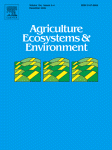Ver ítem
- xmlui.general.dspace_homeCentros Regionales y EEAsCentro Regional Patagonia NorteEEA BarilocheArtículos científicosxmlui.ArtifactBrowser.ItemViewer.trail
- Inicio
- Centros Regionales y EEAs
- Centro Regional Patagonia Norte
- EEA Bariloche
- Artículos científicos
- Ver ítem
Exploring drivers and levels of technology adoption for ecological intensification of pastoral systems in north Patagonia drylands
Resumen
Although pastoral systems make a significant contribution to food security, they are also pointed out as being responsible for substantial environmental impact. Ecological intensification through process- rather than inputbased technologies has been proposed as a means to achieve economic, environmental, and social win-win situations. We studied structural diversity, technology adoption, farmer´s strategies, and functional attributes (productivity,
[ver mas...]
Although pastoral systems make a significant contribution to food security, they are also pointed out as being responsible for substantial environmental impact. Ecological intensification through process- rather than inputbased technologies has been proposed as a means to achieve economic, environmental, and social win-win situations. We studied structural diversity, technology adoption, farmer´s strategies, and functional attributes (productivity, reproductive efficiency, greenhouse gas emissions, diversification, and self-sufficiency) of pastoral systems in North Patagonia based on interviews of 70 farms with the following objectives: (a) to analyze farm
structural characteristics as drivers of technology adoption for ecological intensification, (b) to describe their association with farmers´livelihood strategies, and (c) to explore trade-offs and synergies among functional attributes. An ongoing ecological intensification was revealed based on the adoption of technologies towards animal´s welfare, survival, and overall systems´efficiency, on-farm produced feed (self-sufficiency), and product diversification, promoting nutrient re-cycling within farm boundaries. Four farm types were differentiated by their access to information exchange channels, which together with labor characteristics determined technology adoption and farmers´ strategies. The main strategy of family farms that exhibited low to no hired labor, and intermediate to low access to information, was the diversification of products or incomes. Larger farms, with hired labor and access to information exchange channels, had an entrepreneurial strategy towards increasing production efficiencies. Enteric emission intensity per unit product and area exhibited significant trade-offs with meat production (Spearman ρ = 0.87; Y = 0.459 X + 0.352; R2 = 0.95), and synergies with reproduction efficiency (Spearman ρ = 0.51; Y = 0.013 X + 1.612; R2 = 0.28), respectively. Improving individual animal
production instead of per unit area is encouraged to prevent overgrazing and land degradation, searching for win-win’s between emission mitigation and livestock production.
[Cerrar]

Fuente
Agriculture, Ecosystems and Environment 324 : Art. 107704 (Febrero 2022)
Fecha
2022-02
Editorial
Elsevier
ISSN
0167-8809
Formato
pdf
Tipo de documento
artículo
Palabras Claves
Derechos de acceso
Restringido
 Excepto donde se diga explicitamente, este item se publica bajo la siguiente descripción: Creative Commons Attribution-NonCommercial-ShareAlike 2.5 Unported (CC BY-NC-SA 2.5)
Excepto donde se diga explicitamente, este item se publica bajo la siguiente descripción: Creative Commons Attribution-NonCommercial-ShareAlike 2.5 Unported (CC BY-NC-SA 2.5)

